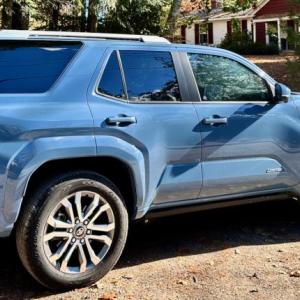No longer just a truck: Toyota 4Runner 4WD Limited
 Totally overhauled for 2025, the 4Runner has a new interior and new connectivity and safety technology as well as new powertrains and sheet metal, yet it is unmistakably a 4Runner. Its over-the-road dynamics have improved substantially while its off-road capability should be no less than before. This color is Heritage Blue.
Totally overhauled for 2025, the 4Runner has a new interior and new connectivity and safety technology as well as new powertrains and sheet metal, yet it is unmistakably a 4Runner. Its over-the-road dynamics have improved substantially while its off-road capability should be no less than before. This color is Heritage Blue.
 Truck cabins haven’t looked like truck cabins for a long time now. The 4Runner Limited’s leather seats are heated and cooled and electrically adjustable, and the wheel is heated and adjusts electrically too. The knob lower left on the console is the drive mode selector. The Limited’s 14-inch touchscreen is especially easy to use, but many functions are controlled by proper buttons and knobs. The lettering on the driver’s screen and on the switches below the wheel can be difficult to make out.
Truck cabins haven’t looked like truck cabins for a long time now. The 4Runner Limited’s leather seats are heated and cooled and electrically adjustable, and the wheel is heated and adjusts electrically too. The knob lower left on the console is the drive mode selector. The Limited’s 14-inch touchscreen is especially easy to use, but many functions are controlled by proper buttons and knobs. The lettering on the driver’s screen and on the switches below the wheel can be difficult to make out.
 Totally overhauled for 2025, the 4Runner has a new interior and new connectivity and safety technology as well as new powertrains and sheet metal, yet it is unmistakably a 4Runner. Its over-the-road dynamics have improved substantially while its off-road capability should be no less than before. This color is Heritage Blue.
Totally overhauled for 2025, the 4Runner has a new interior and new connectivity and safety technology as well as new powertrains and sheet metal, yet it is unmistakably a 4Runner. Its over-the-road dynamics have improved substantially while its off-road capability should be no less than before. This color is Heritage Blue.
 Truck cabins haven’t looked like truck cabins for a long time now. The 4Runner Limited’s leather seats are heated and cooled and electrically adjustable, and the wheel is heated and adjusts electrically too. The knob lower left on the console is the drive mode selector. The Limited’s 14-inch touchscreen is especially easy to use, but many functions are controlled by proper buttons and knobs. The lettering on the driver’s screen and on the switches below the wheel can be difficult to make out.
Truck cabins haven’t looked like truck cabins for a long time now. The 4Runner Limited’s leather seats are heated and cooled and electrically adjustable, and the wheel is heated and adjusts electrically too. The knob lower left on the console is the drive mode selector. The Limited’s 14-inch touchscreen is especially easy to use, but many functions are controlled by proper buttons and knobs. The lettering on the driver’s screen and on the switches below the wheel can be difficult to make out.
Maybe you’ve heard this before: There’s good news and there’s bad news. This time it’s about the new 4Runner, the Toyota Highlander’s tougher cousin. It’s tougher because it’s bolted to a separate frame while the similar-size Highlander is a crossover SUV with a monocoque body — an oversize car to the 4Runner’s truck. And it’s new because for 2025 it got a roof-to-pavement re-do, the first one in 15 years.
The ‘25 is now the sixth generation of the 4Runner and it boasts an all-new platform, two new engine options, a new transmission, a restyled exterior, a revamped interior with updated tech, and an updated suite of safety and self-driving features. Yet at first glance it looks just like the old one, which must be a comfort to owners who put up with the previous 4Runner’s foibles in favor of its strengths.
Those strengths revolved around utility and off-road chops plus the sort of stone-axe longevity that protects resale value. The foibles were an underpowered engine and an inadequate transmission that had the old 4Runner downshifting constantly on hills while trying to hold the speed limit. Mushy handling and tiller-like steering didn’t help its on-road demeanor either.
The previous 4Runner’s 270-horsepower V-6 and its 5-speed transmission are gone. The new powerplants are a 2.4-litre, 278-horsepower turbo Four or essentially the same engine with an electric motor that boosts the output to 326 horsepower and 465 pound-feet of torque; both are hooked up to a modern 8-speed automatic transmission. The power gain isn’t as significant as the more flexible transmission, which lets the 4Runner make better use of its engines. In fact, the new Four could use more power yet; I haven’t driven the hybrid 4Runner, but that might be the better choice, at least performance-wise.
4Runners are available with rear-wheel drive, but why? (Toyota fans who opt out of 4WD should choose the Highlander instead.) With 4WD comes a push-button transfer case with high and low gear ranges, for normal and off-road driving, a locking rear differential and 6,000 pounds of towing capacity. Boonie-bashing options include disconnecting stabilizer bars, off-road cruise control and even manually adjustable dampers.
A quick skim of the new 4Runner’s spec sheet, complete with approach, departure and break-over angles, should comfort the hardest of hard-core off-roaders that the 4Runner has not gone soft. Even the manual roll-down rear window is still with us. And alongside the new-found highway manners comes Toyota’s latest suite of active driving assistance, Safety Sense 3.0, and all the other digital and electronic features we can no longer live without.
OK, the bad news. This is AD 2025, not 1995, but our 4WD Limited barely reached 20 miles per gallon, in town or on the thruway. Other trim levels may best this few by two or three MPG but, thanks to an extra 600 pounds of electric motor and battery, even the hybrid 4Runner reportedly tops out at only about 23 MPG. This is one of the prices we pay for ruggedness and off-road capability.
The other price we pay is the second bit of bad news. Our vehicle’s MSRP is $62,230—luxury-car territory not all that long ago. This includes $1,450 in destination fees and $3,380 in add-ons such as powered running boards ($1,005), a minuscule folding third-row seat ($1,330) and an accessory Tow Tech package ($330) plus floor mats and a few other doodads.
The entry-level 4Runner, the stripper SR5, starts at $42,735, or about $7,000 below the current average new-car price in America, but the next trim level, the TRD Sport, comes in at just about 50 grand. Political grandstanding aside, inflation is still with us and prices are not coming down.



























